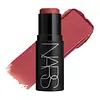What's inside
What's inside
 Key Ingredients
Key Ingredients

 Benefits
Benefits

 Concerns
Concerns

 Ingredients Side-by-side
Ingredients Side-by-side

Polymethyl Methacrylate
Triethylhexanoin
MaskingDimethicone
EmollientCetyl Ethylhexanoate
EmollientSynthetic Fluorphlogopite
Mica
Cosmetic ColorantHydrogenated Polydecene
EmollientButyrospermum Parkii Butter
Skin ConditioningPolyethylene
AbrasiveIsononyl Isononanoate
EmollientC10-18 Triglycerides
EmollientMicrocrystalline Wax
Emulsion StabilisingEuphorbia Cerifera Wax
Sorbitan Sesquiisostearate
EmulsifyingCaesalpinia Sappan Bark Extract
Skin ConditioningPhenoxyethanol
PreservativeCaprylyl Glycol
EmollientTocopheryl Acetate
AntioxidantTin Oxide
AbrasiveCI 77891
Cosmetic ColorantCI 16035
Cosmetic ColorantCI 77491
Cosmetic ColorantCI 19140
Cosmetic ColorantCI 77499
Cosmetic ColorantPolymethyl Methacrylate, Triethylhexanoin, Dimethicone, Cetyl Ethylhexanoate, Synthetic Fluorphlogopite, Mica, Hydrogenated Polydecene, Butyrospermum Parkii Butter, Polyethylene, Isononyl Isononanoate, C10-18 Triglycerides, Microcrystalline Wax, Euphorbia Cerifera Wax, Sorbitan Sesquiisostearate, Caesalpinia Sappan Bark Extract, Phenoxyethanol, Caprylyl Glycol, Tocopheryl Acetate, Tin Oxide, CI 77891, CI 16035, CI 77491, CI 19140, CI 77499
Isodecyl Isononanoate
EmollientSilica
AbrasiveOctyldodecyl Stearoyl Stearate
EmollientSynthetic Wax
AbrasiveIsodecyl Neopentanoate
EmollientC12-15 Alkyl Benzoate
AntimicrobialSynthetic Fluorphlogopite
CI 77120
Cosmetic ColorantIllite
AbrasiveLimnanthes Alba Seed Oil
Skin ConditioningSorbitan Isostearate
EmulsifyingSorbitan Sesquioleate
EmulsifyingStearalkonium Hectorite
Gel FormingPrunus Persica Kernel Oil
EmollientEthylhexylglycerin
Skin ConditioningTocopherol
AntioxidantRheum Palmatum Root Extract
AstringentMica
Cosmetic ColorantTocopheryl Acetate
AntioxidantIsopropyl Titanium Triisostearate
EmollientAluminum Hydroxide
EmollientTriethoxycaprylylsilane
Tin Oxide
AbrasiveWater
Skin ConditioningButylene Glycol
HumectantPhenoxyethanol
PreservativeCI 16035
Cosmetic ColorantCI 77891
Cosmetic ColorantCI 77491
Cosmetic ColorantCI 42090
Cosmetic ColorantCI 19140
Cosmetic ColorantIsodecyl Isononanoate, Silica, Octyldodecyl Stearoyl Stearate, Synthetic Wax, Isodecyl Neopentanoate, C12-15 Alkyl Benzoate, Synthetic Fluorphlogopite, CI 77120, Illite, Limnanthes Alba Seed Oil, Sorbitan Isostearate, Sorbitan Sesquioleate, Stearalkonium Hectorite, Prunus Persica Kernel Oil, Ethylhexylglycerin, Tocopherol, Rheum Palmatum Root Extract, Mica, Tocopheryl Acetate, Isopropyl Titanium Triisostearate, Aluminum Hydroxide, Triethoxycaprylylsilane, Tin Oxide, Water, Butylene Glycol, Phenoxyethanol, CI 16035, CI 77891, CI 77491, CI 42090, CI 19140
Ingredients Explained
These ingredients are found in both products.
Ingredients higher up in an ingredient list are typically present in a larger amount.
Ci 16035 is a synthetic dark-red dye. This dye is created from an acid called Allura red AC, an azo dye.
Azo dyes need to be purified thoroughly before use. This makes them more stable and longer lasting.
This dye is commonly used in foods, approved by both the FDA and EFSA.
Learn more about CI 16035CI 19140 is also known as Tartrazine. Tartrazine is a synthetic dye used in cosmetics, foods, and medicine to add a yellow color.
Tartrazine is created from petroleum and is water-soluble.
Some people may experience allergies from this dye, especially asthmatics and those with an aspirin intolerance.
Learn more about CI 19140Ci 77491 is also hydrated iron III oxide. It's sole purpose is to give a red/pink hue to products.
Iron III oxides are classified as inorganic chemicals for coloring.
Synthetically created Ci 77491 is considered safer than those naturally found. This is because the synthetically created version may contain less impurities. Iron oxides are generally non-toxic and non-allergenic.
Learn more about CI 77491Ci 77891 is a white pigment from Titanium dioxide. It is naturally found in minerals such as rutile and ilmenite.
It's main function is to add a white color to cosmetics. It can also be mixed with other colors to create different shades.
Ci 77891 is commonly found in sunscreens due to its ability to block UV rays.
Learn more about CI 77891Mica is a naturally occurring mineral used to add shimmer and color in cosmetics. It can also help improve the texture of a product or give it an opaque, white/silver color.
Serecite is the name for very fine but ragged grains of mica.
This ingredient is often coated with metal oxides like titanium dioxide. Trace amounts of heavy metals may be found in mica, but these metals are not harmful in our personal products.
Mica has been used since prehistoric times throughout the world. Ancient Egyptian, Indian, Greek, Roman, Aztec, and Chinese civilizations have used mica.
Learn more about MicaPhenoxyethanol is a preservative that has germicide, antimicrobial, and aromatic properties. Studies show that phenoxyethanol can prevent microbial growth. By itself, it has a scent that is similar to that of a rose.
It's often used in formulations along with Caprylyl Glycol to preserve the shelf life of products.
Synthetic Fluorphlogopite is the synthethic version of mica. It consists of fluorine, aluminum and silicate.
Synthetic Fluorphlogopite is used to add volume to products.
It is considered non-irritating on the skin.
Learn more about Synthetic FluorphlogopiteTin Oxide is an inorganic oxide used to add opacity and volume to a product. In nature, it is already found in mineral form. The main ore of tin is an opaque and shiny mineral called casseterite.
Tin Oxide helps remove translucency in a product, or make it more opaque. Besides adding opacity, tin oxide is used for bulking to add volume.
Tocopheryl Acetate is AKA Vitamin E. It is an antioxidant and protects your skin from free radicals. Free radicals damage the skin by breaking down collagen.
One study found using Tocopheryl Acetate with Vitamin C decreased the number of sunburned cells.
Tocopheryl Acetate is commonly found in both skincare and dietary supplements.
Learn more about Tocopheryl Acetate